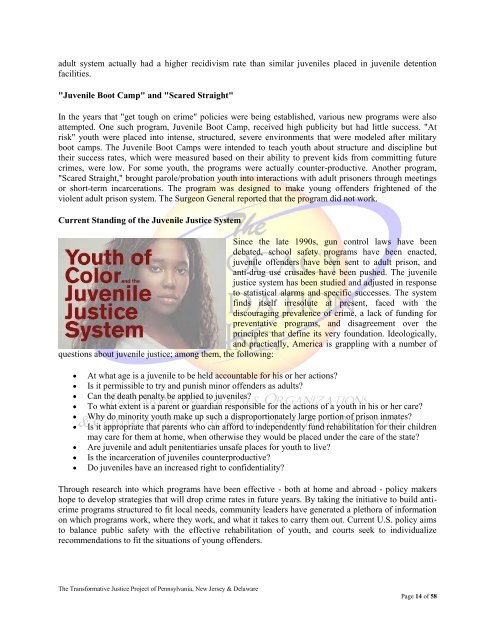Transformative Justice Project Manual
Transformative Justice Project Manual
Transformative Justice Project Manual
You also want an ePaper? Increase the reach of your titles
YUMPU automatically turns print PDFs into web optimized ePapers that Google loves.
adult system actually had a higher recidivism rate than similar juveniles placed in juvenile detention<br />
facilities.<br />
"Juvenile Boot Camp" and "Scared Straight"<br />
In the years that "get tough on crime" policies were being established, various new programs were also<br />
attempted. One such program, Juvenile Boot Camp, received high publicity but had little success. "At<br />
risk" youth were placed into intense, structured, severe environments that were modeled after military<br />
boot camps. The Juvenile Boot Camps were intended to teach youth about structure and discipline but<br />
their success rates, which were measured based on their ability to prevent kids from committing future<br />
crimes, were low. For some youth, the programs were actually counter-productive. Another program,<br />
"Scared Straight," brought parole/probation youth into interactions with adult prisoners through meetings<br />
or short-term incarcerations. The program was designed to make young offenders frightened of the<br />
violent adult prison system. The Surgeon General reported that the program did not work.<br />
Current Standing of the Juvenile <strong>Justice</strong> System<br />
Since the late 1990s, gun control laws have been<br />
debated, school safety programs have been enacted,<br />
juvenile offenders have been sent to adult prison, and<br />
anti-drug use crusades have been pushed. The juvenile<br />
justice system has been studied and adjusted in response<br />
to statistical alarms and specific successes. The system<br />
finds itself irresolute at present, faced with the<br />
discouraging prevalence of crime, a lack of funding for<br />
preventative programs, and disagreement over the<br />
principles that define its very foundation. Ideologically,<br />
and practically, America is grappling with a number of<br />
questions about juvenile justice; among them, the following:<br />
<br />
<br />
<br />
<br />
<br />
<br />
<br />
<br />
<br />
At what age is a juvenile to be held accountable for his or her actions?<br />
Is it permissible to try and punish minor offenders as adults?<br />
Can the death penalty be applied to juveniles?<br />
To what extent is a parent or guardian responsible for the actions of a youth in his or her care?<br />
Why do minority youth make up such a disproportionately large portion of prison inmates?<br />
Is it appropriate that parents who can afford to independently fund rehabilitation for their children<br />
may care for them at home, when otherwise they would be placed under the care of the state?<br />
Are juvenile and adult penitentiaries unsafe places for youth to live?<br />
Is the incarceration of juveniles counterproductive?<br />
Do juveniles have an increased right to confidentiality?<br />
Through research into which programs have been effective - both at home and abroad - policy makers<br />
hope to develop strategies that will drop crime rates in future years. By taking the initiative to build anticrime<br />
programs structured to fit local needs, community leaders have generated a plethora of information<br />
on which programs work, where they work, and what it takes to carry them out. Current U.S. policy aims<br />
to balance public safety with the effective rehabilitation of youth, and courts seek to individualize<br />
recommendations to fit the situations of young offenders.<br />
The <strong>Transformative</strong> <strong>Justice</strong> <strong>Project</strong> of Pennsylvania, New Jersey & Delaware<br />
Page 14 of 58

















